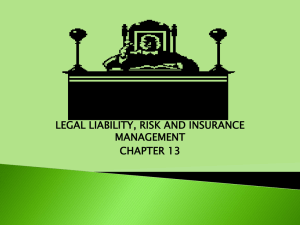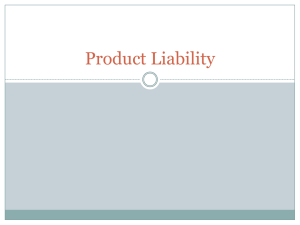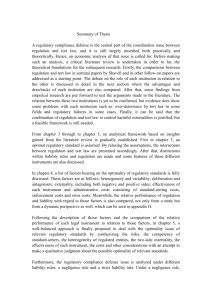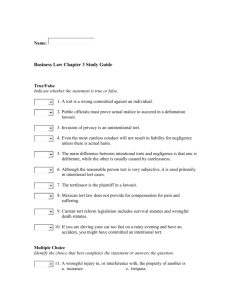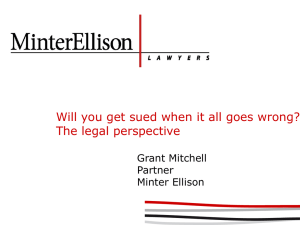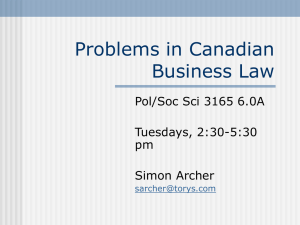Torts and Legal Liability – PowerPoint
advertisement
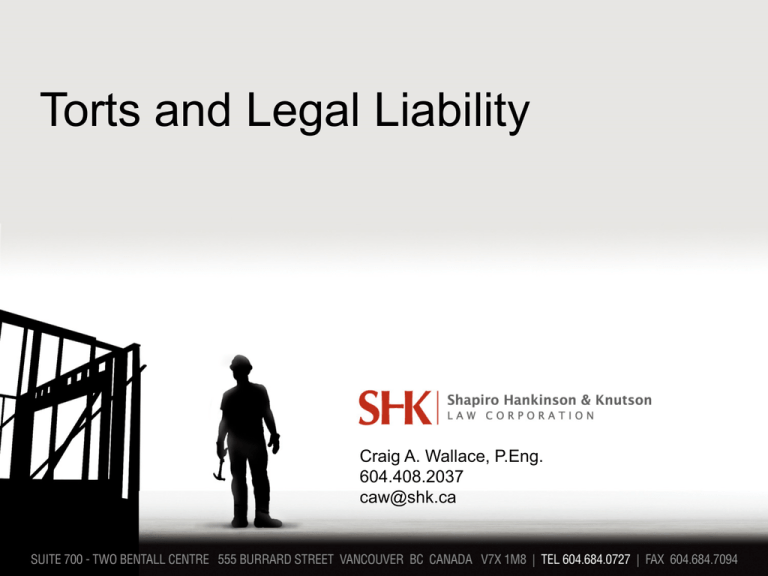
Torts and Legal Liability Craig A. Wallace, P.Eng. 604.408.2037 caw@shk.ca Essentials of Tort Law Tort Law Origins Historically dealt with "duty" owed to everyone you haven't agreed with in advance "Tort" = “Wrong” The law of negligence Personal injury Property damage Not for economic losses Tort Law Operation Must take reasonable care to avoid acts or omissions that you can reasonably foresee would be likely to injure your neighbour “Negligence is the omission to do something which a reasonable man, guided upon those considerations which ordinarily regulate the conduct of human affairs, would do, or doing something which a prudent and reasonable man would not do.” Reasonable Care -- The "reasonable man" test “The reasonable man is a mythical creature of the law whose conduct is the standard by which the Courts measure the conduct of all other persons and find it to be proper or improper in particular circumstances as they may exist from time to time. He is not an extraordinary or unusual creature; he is not superhuman; he is not required to display the highest skill of which anyone is capable; his is not a genius who can perform uncommon feats, nor is he possessed of unusual powers of foresight. He is a person of normal intelligence who makes prudence a guide to his conduct. He does nothing that a prudent man would not do and does not omit to do anything that a prudent man would do. His conduct is guided by considerations which ordinarily regulate the conduct of human affairs. His conduct is the standard ‘adopted in the community by persons of ordinary intelligence and prudence’.” The "Reasonable Engineer or Geoscientist" “How do you test whether this act or failure is negligent? In an ordinary case it is generally said, that you judge that by the action of the man in the street. He is the ordinary man. In one case it has been said that you judge it by the conduct of the man on the top of a Clapham omnibus. He is the ordinary man. But where you get a situation which involves the use of some special skill or competence, then the test whether there has been negligence or not is not the test of the man on the top of a Clapham omnibus, because he has not got this special skill. The test is the standard of the ordinary skilled man exercising and professing to have that special skill. A man need not possess the highest expert skill at the risk of being found negligent. It is well established law that it is sufficient if he exercises the ordinary skill of an ordinary competent man exercising that particular art.” Application of Tort Law to Commercial Transactions Historically, liability had to follow contractual chain Manufacturer ↓ Distributor ↓ Consumer Application of Tort Law to Commercial Transactions Donoghue v. Stevenson (1932) changed that, but still required personal injury or property damage Winnipeg Condominium (1995) extended tort liability to "pure economic loss", provided there was a "danger to health or safety" For most engineers and many geoscientists, almost any negligence could be said to result in a "danger to health or safety“ Result is that engineers and geoscientists are liable, not just to their clients, but to third parties – subsequent owners, and others with whom they have no contract. Who is my "neighbour" and what is "foreseeable"? • There must be a "sufficiently close relationship between the parties" (proximity) to "justify imposition of a duty" and • There must be no "policy considerations" to prevent the imposition of liability Very complicated to determine, but the number of people to whom a duty is owed is probably expanding Professionals and Tort Liability Negligent Misrepresentation Five requirements from The Queen v. Cognos: (1) there must be a duty of care based on a ‘special relationship’ between the representor and the representee; (2) the representation in question must be untrue, inaccurate, or misleading; (3) the representor must have acted negligently in making said representation; (4) the representee must have relied, in a reasonable manner, on said negligent misrepresentation; and (5) the reliance must have been detrimental to the representee in the sense that damages resulted. Failure to Warn Just as there can be liable for negligent statements, there can be liability for remaining silent where it is negligent not to speak up Surrey v. Carrol Hatch “Scope of Work” cases Personal Liability for Negligence London Drugs v. Kuehne & Nagel Can give officers and employees the benefit of limitations of liability, but only with respect to a claim by the client Joint and Several Liability The injured party can recover 100% of his/her loss from a party who is only 10% liable Limitation Period Although the limitation period for all actions is now two years, the running of time is postponed until the plaintiff knows of the damage and the fact that he/she has a claim against the defendant. Ultimate limitation period is 15 years from the events in question. Essentials of Tort Law Craig A. Wallace, P.Eng. 604.408.2037 caw@shk.ca




